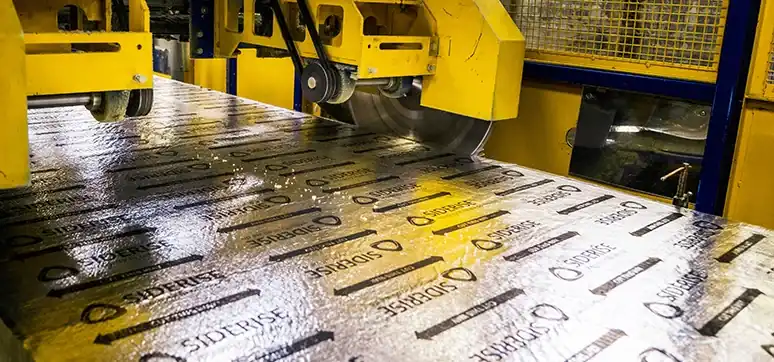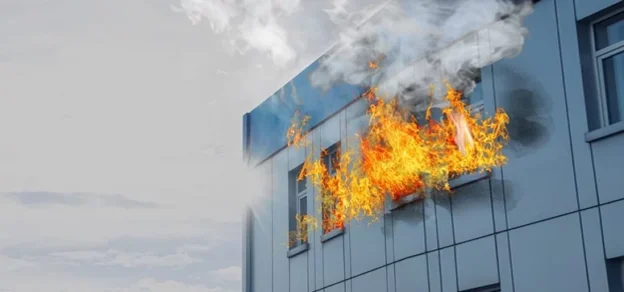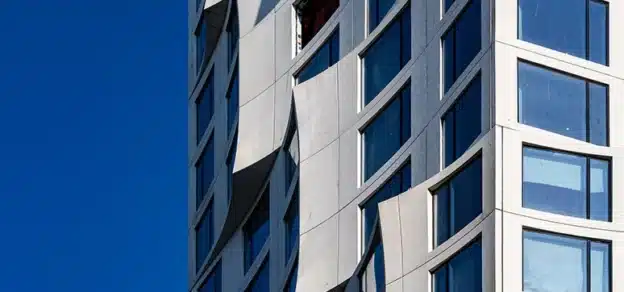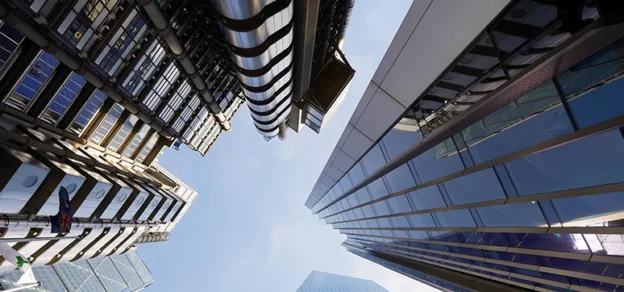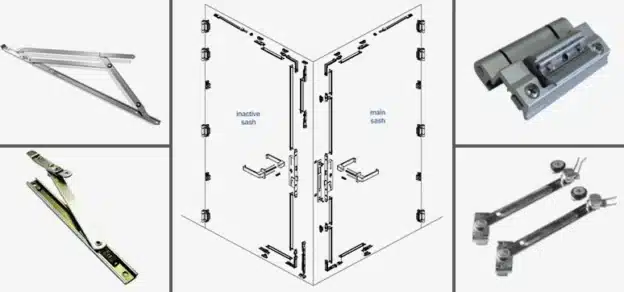As more and more sky-high multi-occupancy buildings emerge across India’s densely populated megacities, it is not only crucial that curtain wall façades are designed and constructed to withstand constant movement but that the passive fire protection measures incorporated within can accommodate this movement. With clean lines, sleek glass surfaces and technological glazing innovations, curtain walls offer an ultra-modern aesthetic, floor-to-floor natural daylight and excellent weatherproofing. Unlike more traditional wall constructions, curtain walls are not part of the building’s supporting structure.

They are a non-loadbearing and self-supporting vertical enclosure or envelope that separates and protects the internal environment from external climatic conditions. This makes them highly susceptible to movement caused by wind and rain loads, seismic sway, occupancy loads on the floor slab and thermal loads that cause the structure to expand and distort. Whilst various calculations and computer modelling can help designers to better understand the range of potential movement and work needed to mitigate it, it cannot be designed out completely.
Consequently, curtain-walled buildings are commonly built with a gap between the edge of the floor slab and the façade itself to allow for both vertical and lateral deflection. This is known as the movement gap or the expansion joint and the designed perimeter gap can vary considerably in void size. For instance, this can be wider in certain cases such as where buildings are built in locations with high movement risk (e.g. frequent seismic activity) or include more dynamic, complex design elements (e.g. curved elevations). Whilst vital for allowing free movement without damage to the structure, this gap can present a huge challenge when it comes to ensuring passive fire protection.
Perimeter Fire Seals
Unprotected and improperly protected movement gaps can provide a clear path for flames, smoke, and hot gases to be drawn upwards due to the chimney effect, enabling the fire to spread floor to floor. To inhibit this, perimeter fire seals— also referred to as firestops— must be installed at each floor level to maintain the integrity of the compartment floor slab right up to the internal surface of the curtain wall and achieve compartmentation. However, as the gap width is in constant flux, it is important that the specified solution not only achieves the required fire resistance, but that it can maintain a tight seal whilst withstanding constant inward and outward movement for the lifetime of the building. If the perimeter seal does not adequately recover from the compression cycles, then gaps could form between the curtain wall façade system and the structure, allowing the fire to spread through the building envelope and putting people’s lives and property at risk.
It is thus recommended that curtain wall perimeter fire seals provide a 7.5% or greater movement capability at the movement joint, allowing both compression and flex. To do this, they must be installed under compression. The Association for Specialist Fire Protection (ASFP) stresses the importance of this in its Red Book- Firestopping: Linear Joint Seals, Penetration Seals & Cavity Barriers (4th Edition): “The effectiveness of the fire stop will depend on the ability of the curtain walling/cladding system to maintain the compression fit for the duration of the required fire resistance period. Unless the system is installed pre-compressed and can move to maintain compression, premature failure of the fire-stopping may occur.”
Therefore, careful consideration needs to be given to how well a firestopping product can withstand these compressive forces over time, whilst retaining its ability to recover/flex.
Form and Fit
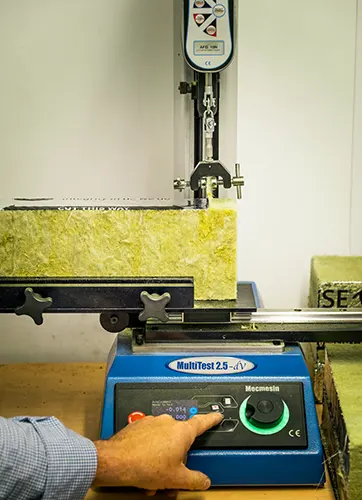
There are several perimeter fire seal options on the market, and their suitability for curtain wall applications is dependent on the compressibility of the product, and how well it can recover to allow for flex. Traditional approaches required installers to cut and compress non-combustible insulation material (also known as safing) onsite and seal it with a sprayed-on wet compound. They are often referred to as ‘wet systems’ and must be applied in dry conditions to prevent washout. Once the compound is applied, the only way to verify if the right compression has been achieved is through destructive testing. This type of system also typically uses standard rock wool insulation with horizontal fibres. Whilst this makes the product stable, this orientation also makes them difficult to repeatedly compress without resulting in a breakdown of the bonding between the fibres. If this happens, the product will not recover and flex in line with the façade movement, resulting in gaps and distortions forming and causing the compartmentation to fail.
However, innovative single-part ‘dry systems’ have been developed that use vertical fibre orientation. They are engineered through a unique manufacturing process that involves cutting a special formulation stone wool slabs into sections and rotating the sections 90 degrees to vertically orient the fibres.
These sections are then laterally compressed using an automated factory process to remove any gaps between the sections and assist in uniformity of product density. While the inline compression is being applied, foil facings are simultaneously heat fused to retain the ‘pre-compression’. This aluminium foil also provides weather protection without the need for wet seals. They are then further compressed by 10% when they are installed, wrinkling the foil, and making it very easy to confirm if they have been installed correctly.
Accounting for Movement in Test Standards
As with any fire protection product, it is vital that curtain wall perimeter fire seals are tested to standards that accurately reflect how they will be used and the conditions they will be subjected to. This ensures that their fire resistance performance is truly accurate. Consequently, EN 1364-4 and ASTM E2307, the most commonly used fire test standards for perimeter fire seals in curtain wall constructions include provision for movement.
The EN 13830 product standard for curtain walling stipulates fire resistance testing in accordance with EN 1364-4 and durability and cycling in accordance with ETAG 026 (now superseded by EAD 350141-00-1106). EN 1364-4: 2014 – Fire resistance tests for non-load bearing elements (Curtain walling – part configuration) is the European standard for curtain wall perimeter fire seals. It is a part configuration test that applies to both Type A – fire rated, and Type B – non fire rated, curtain wall systems. Non fire rated façades are typically made from aluminium and therefore when being tested, the critical spandrel zone requires protection to enable it to survive for the duration of the test.
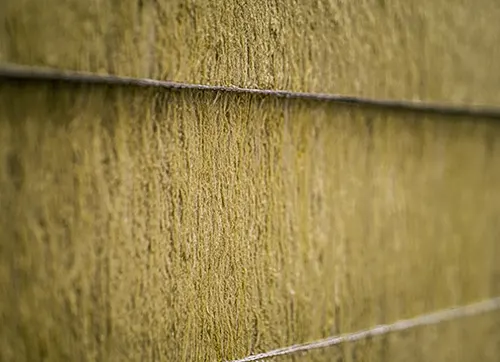
As the test construction is representative of curtain wall construction, the perimeter fire seal will be subjected to movement caused by deflection of both the floor slab and the curtain wall façade due to the thermal load of the fire. However, EN 1364-4 also includes provision for long-term façade movement by referring to the European Technical Approval Guidelines 026-3, which is now superseded by European Assessment Document (EAD) 350141- 00-1106. This is a harmonised technical specification for linear joint and gap seals developed by the European Organisation for Technical Assessment (EOTA) for cases where a product is not fully covered by harmonised European standards. EADs are the basis for issuing European Technical Assessments (ETAs).
EAD 3501141-00-1106 requires that the perimeter seal is subjected to a minimum of 500 cycles between the minimum and maximum joint width, to simulate wind sway, seismic activity and thermal load at a rate designated by the test applicant. After this cycling, the construction is left to stabilise for 24 hours and cannot be altered before testing. The pre-cycled perimeter seal and curtain wall system is then exposed to furnace testing of over 1000°C at 20Pa positive pressure as per the EN 1364-4:2014 test standard. If manufacturers are voluntarily applying a CE Mark, it is imperative to understand if they have been tested in accordance with EAD 350141-00-1106 as it is only in these cases that true movement testing has been applied.
EN 1364-4 has also been the recommended test standard by the Association for Specialist Fire Protection (ASFP) since 2014, as per their Advisory Note 7 – “The ASFP recommends that horizontal linear gap seals used in association with curtain walls are only tested to BS EN 1364-4 and that test evidence obtained using BS EN 1366-4 cannot be used to support that end-use application” It is important to note that EN 1366-4 is a static test whereby the specimen is sandwiched between two concrete floor slabs. As such, it cannot be used to support curtain walling applications. The same is also true for the older BS 476-20 test standard.
ASTM E2307-20 ‘Standard Test Method for Determining Fire Resistance of Perimeter Fire Barriers’ is the American test standard for curtain wall firestops. This is widely referred to in regulations in the USA, UAE, and various regions in the wider Middle East and Asia Pacific. It is designed to measure the performance of the perimeter fire seal only, assessing its ability to “maintain a seal to prevent fire spread during the deflection and deformation of the exterior wall assembly and floor assembly during the fire test.” It uses intermediate scale multi-storey apparatus to expose the perimeter joint to fire, both from the room where the fire started, and the exterior as the fire plume exits the room of fire origin through a window opening.
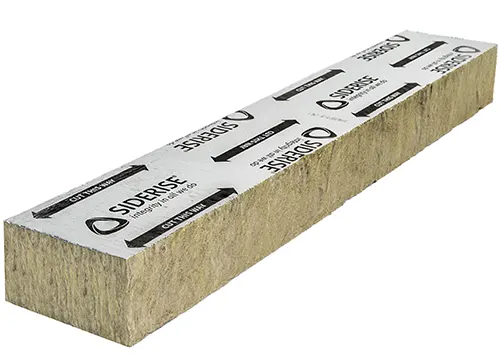
Like EN 1364-4, it also includes provisions for pre-cycling, or ‘cold’ movement of the test specimen before the test begins, covering thermal load, wind sway, seismic movement, and all these combined. The rates for cycling and the minimum number of movement cycles depend upon the type of movement required. Whilst ASTM E2307 clearly states the criteria for the movement cycling, it is not uncommon to see listings where movement has been evaluated in accordance with ASTM E1399/E1399M-97(2017) – Standard Test Method for Cyclic Movement and Measuring the Minimum and Maximum Joint Widths of Architectural Joint Systems – a cyclic movement test standard for linear joints – not a perimeter fire barrier construction: two very different things.
Checking if these tests have been third-party certified by an accredited organisation that conforms to strict ISO requirements is an important step for specifiers to ensure confidence in the performance and consistency of the products. Gaining certification is not easy. It is a tough and lengthy process, usually involving reviewing product test data against appropriate standards and requirements, as well as submitting product samples for analysis and as comparative samples. Maintaining certification is even more arduous with ongoing surveillance activities including unannounced factory visits and random audits. If any significant changes are observed, certification is withdrawn, and re-testing is required.
Manufacturers of these products may also carry out their own accelerated age testing to further determine the robustness of their products. The Significance of the ‘Spandrel Zone’ Both EN 1364-4 and ASTM E2307 are tests of the façade system. Accordingly, it is essential that the complete tested and certified solution, including protection materials for the critical spandrel zone in the case of aluminium framed façades, is fully understood and detailed at the time of project design and specification. The perimeter fire seal, spandrel insulation, and any additional perimeter fire barrier boards for protecting the spandrel panel, mullions and transoms all function together to deliver performance and cannot be used interchangeably or substituted without repeating the full curtain wall façade set of tests.
Fit for Function
Curtain walls are an attractive and functional façade option, but sufficient regard must be given to ensuring the passive fire protection measures are appropriate to avoid any risk of compromising the property protection and life safety strategies. Specifying perimeter fire seals that have been engineered and third-party tested and certified to ensure their performance reflects their intended use as part of a constantly moving curtain wall façade, is a safe specification strategy for containing fire and smoke and providing peace of mind that they will protect properly for the lifetime of the building.
For more information and guidance on passive fire protection, visit www.siderise.com
For more details, contact:
Siderise India Pvt. Ltd,
Apeejay Business Centre, Cabin 10, 1st Floor, Apeejay Express, Plot 87, Sector 17, Navi Mumbai, Maharashtra 400703, India;
T: +91 998 700 4611; / Mail at: siderisein@siderise.com;
Website: www.siderise.in
